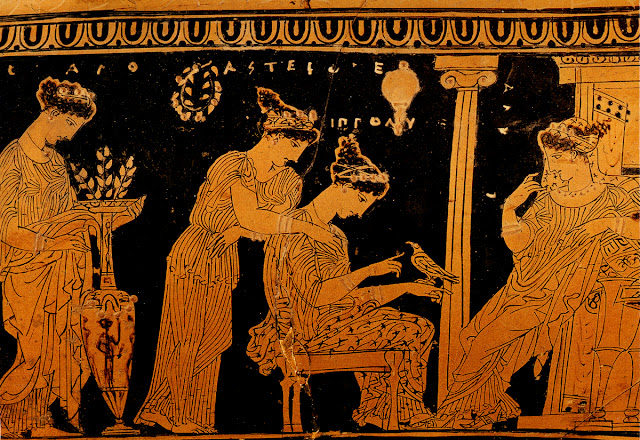Древние Греки
уделяли огромное внимание своим прическам. В классической Греции для мужчин
было модным иметь короткие, но завитые волосы. Женщины же никогда не стригли
свои волосы. За исключением тех, кто был в трауре или в рабстве. Обычно женщины начесывали и завивали волосы.
Использовали для этого различные гребешки: из слоновой кости, панциря черепахи,
кости, оливкового дерева, бронзы. Выбор материала, конечно же, зависел от
богатства. Женщины, как и мужчины, опрыскивали волосы духами или ароматными маслами.
У детей были длинные волосы. Девочки особенно любили убирать волосы в «конский
хвост».
Нельзя так же
забывать, что у греков блондины пользовались большой популярностью, т.к. светлые
волосы были символом чистоты, принадлежности к богу и высокому социальному
статусу. Поэтому прежде, чем они придумали, как можно осветлять волосы, мужчины
посыпали готовые прически золотой пылью. Женщины предпочитали мыть волосы в
растворе калия и лепестках желтых цветов. Но даже когда всё-таки был разработан
долговременный метод осветления волос, изъянов в качестве окрашивания было
много.
Прическа
завершалась добавлением в нее украшений: начиная от цветов и лент и заканчивая
гребешками и более изысканными украшениями по случаю больших праздников.
Именно благодаря
своей легкости и элегантности, греческие прически остаются популярными и по сей
день!
Les Grecs donnaient beaucoup d'importance à leurs coiffures. Dans l’époque classique les cheveux courts mais bouclés ont été à la mode pour les hommes. Les femmes ne raccourcissaient jamais leurs cheveux (à l’exception d’un deuil ou d’un esclavage). D’habitude les femmes se crêpaient, frisaient et ondulaient les cheveux. Elles ont utilisé pour cela des peignes différents: d’ivoire, d’écailles de tortue, d’os, d’olivier, de bronze. Le choix des matériaux dépendait de la richesse de la personne. Les femmes comme les hommes mettaient dans leur cheveux un peu de parfum ou d’une huile aromatisée. Les enfants portaient les cheveux longs. Les filles aimaient faire une «queue de cheval».
Il ne faut pas oublier que les blondes étaient très populaires chez les Grecs. Les cheveux claires étaient le symbole de la pureté, appartenance à un Dieu et à un haut statut social. C’est pour cela les hommes saupoudraient leurs coiffures avec de la poudre d’or avant qu’ils aient inventé comment éclaircir les cheveux. Les femmes préféraient de laver leurs cheveux dans la solution de potassium avec des pétales de fleurs jaunes. Malgré qu’ils aient élaboré une méthode d’éclaircissement longue terme, il y avait encore des défauts de coloration.
La coiffure se terminait avec une petite décoration. Cela pouvait être une fleur, des rubans ou même des peignes. Pour les grandes fêtes ils mettaient des bijoux plus raffinés.
C’est surtout grâce à son élégance et sa légèreté que le style des coiffures grecques restent si populaire jusqu’à nos jours !
Il ne faut pas oublier que les blondes étaient très populaires chez les Grecs. Les cheveux claires étaient le symbole de la pureté, appartenance à un Dieu et à un haut statut social. C’est pour cela les hommes saupoudraient leurs coiffures avec de la poudre d’or avant qu’ils aient inventé comment éclaircir les cheveux. Les femmes préféraient de laver leurs cheveux dans la solution de potassium avec des pétales de fleurs jaunes. Malgré qu’ils aient élaboré une méthode d’éclaircissement longue terme, il y avait encore des défauts de coloration.
La coiffure se terminait avec une petite décoration. Cela pouvait être une fleur, des rubans ou même des peignes. Pour les grandes fêtes ils mettaient des bijoux plus raffinés.
C’est surtout grâce à son élégance et sa légèreté que le style des coiffures grecques restent si populaire jusqu’à nos jours !
The Greeks paid a lot of attention to their hair. In classical period it was very fashionable for men to have a short cut but curly hair style. Women never cut their hair, except in mourning or if they were slaves. Usually women teased, frizzed and curled their hair. They could use different combs to do it: ivory, tortoiseshell, bones, olive wood or bronze. The choice of the material depended on the wealth. Women as well as men sprayed some perfume or fragrant oil on their hair. Children had long hair. Girls liked to make “ponytails”.
We can’t forget that blonds were very popular in ancient Greece. Light hair was a symbol of purity, God belonging and high society status. That’s why men put some gold powder on their finished hairstyle. Women preferred to wash their hair in solution of potassium with yellow flower’s petals. Even when they invented the long-term hair brightening method, there were still some coloration imperfections.
The hairstyle could be finished with some decoration like flowers, bands, combs and even more refined jewelry for big festive occasion.
The lightness and elegance of the Greek hairstyle made it popular till nowadays!
We can’t forget that blonds were very popular in ancient Greece. Light hair was a symbol of purity, God belonging and high society status. That’s why men put some gold powder on their finished hairstyle. Women preferred to wash their hair in solution of potassium with yellow flower’s petals. Even when they invented the long-term hair brightening method, there were still some coloration imperfections.
The hairstyle could be finished with some decoration like flowers, bands, combs and even more refined jewelry for big festive occasion.
The lightness and elegance of the Greek hairstyle made it popular till nowadays!






